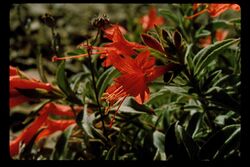Biology:Epilobium septentrionale
| Epilobium septentrionale | |
|---|---|

| |
| Scientific classification | |
| Kingdom: | Plantae |
| Clade: | Tracheophytes |
| Clade: | Angiosperms |
| Clade: | Eudicots |
| Clade: | Rosids |
| Order: | Myrtales |
| Family: | Onagraceae |
| Genus: | Epilobium |
| Species: | E. septentrionale
|
| Binomial name | |
| Epilobium septentrionale (D.D.Keck) R.N.Bowman & Hoch
| |
| Synonyms | |
|
Zauschneria septentrionalis | |
Epilobium septentrionale, with the common names Humboldt County fuchsia and northern willowherb, is a species of willowherb. Like the wildflower zauschneria, this plant was once treated as a member of genus Zauschneria but has more recently been placed with the willowherbs.
Distribution
This species is endemic to Northern California, where it is an uncommon resident of the rocky ledges of the Northern Outer California Coast Ranges.[1]
Description
Epilobium septentrionale is a squat, clumpy perennial growing in thin patches of soil between rocks and sending up a few erect stems. The leaves are oval and pointed, glandular, and covered in a coat of white fuzz.
At the end of each erect branch is a glandular inflorescence bearing a bright red-orange tubular flower 2 or 3 centimeters long. A bunch of stamens and one long pistil protrude obviously from the mouth of the bloom, which is pollinated by nectar-feeding birds. The fruit is a hairy capsule about two centimeters long.
References
External links
Wikidata ☰ Q5383011 entry
 |

